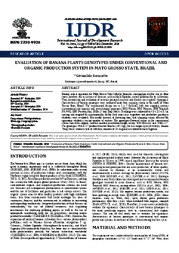Evaluation of banana plants genotypes under conventional and organic production system in Mato Grosso State, Brazil.
Evaluation of banana plants genotypes under conventional and organic production system in Mato Grosso State, Brazil.
Author(s): RONCATTO, G.
Summary: Abstract: Banana crop is important for Mato Grosso State both for domestic consumption and for sale in other states; however, the occurrence of diseases, such as black Sigatoka, caused problems for its cultivation. Thus, introduction and evaluation of resistant genotypes to pests and diseases are required. Agronomic characteristics of banana genotypes were evaluated under two cropping system in the north of Mato Grosso State, Brazil. The experimental design was a 2 x 7 factorial, with two cropping systems (conventional and organic) and seven banana genotypes (BRS Platina, BRS Princesa, BRS Tropical, PA-9401; BRS Pacovan Ken, FHIA-17 and Thap Maeo). Seedlings were cultivated at 4.0 x 2.5 x 1.7 m spacing and irrigated by microsprinkler. In the first crop cycle vegetative and productive genotypes attributes were evaluated. The results showed, at flowering time, that cropping system affected the agronomic attributes, except number of suckers. The genotypes flowered earlier in the conventional system than in the organic, and had smallest pseudostem height, except ‘BRS Princesa’ and ‘FHIA-17’. The genotypes ‘FHIA-17’ produced heavier bunches (49.5 kg), but in a longer cycle (410 days). Banana ‘Thap Maeo’ showed cycle of 360 days, bunches of 24.3 kg and is resistant to black Sigatoka.
Publication year: 2024
Types of publication: Journal article
Keywords: Banana, Cropping systems, Genótipo, Musa, Sigatoka Negra, Sistema de Produção
Observation
Some of Embrapa's publications are published as ePub files. To read them, use or download one of the following free software options to your computer or mobile device. Android: Google Play Books; IOS: iBooks; Windows and Linux: Calibre.
Access other publications
Access the Agricultural Research Database (BDPA) to consult Embrapa's full library collection and records.
Visit Embrapa Bookstore to purchase books and other publications sold by Embrapa.

